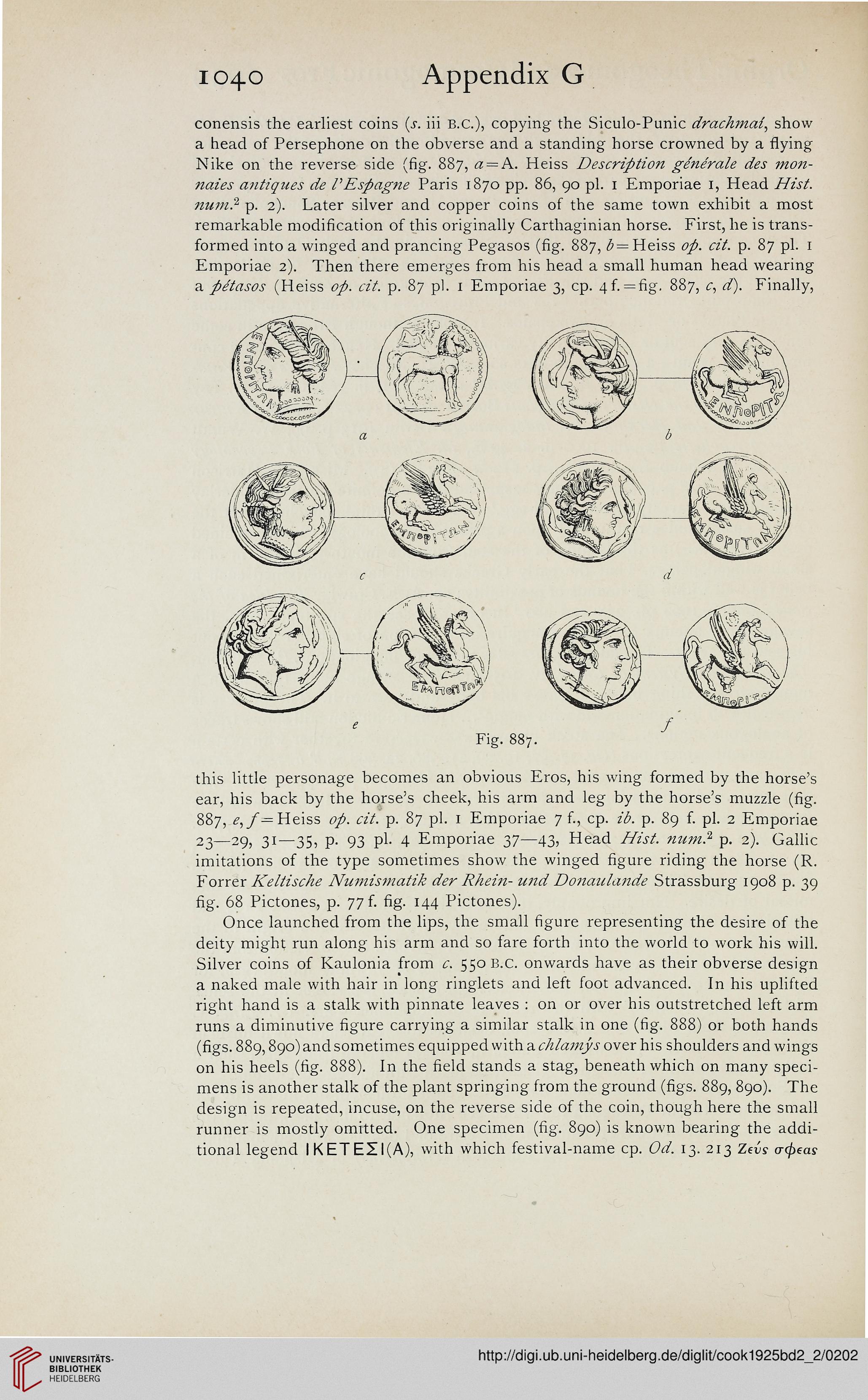1040
Appendix G
conensis the earliest coins (s. iii B.C.), copying the Siculo-Punic drachma?, show
a head of Persephone on the obverse and a standing horse crowned by a flying
Nike on the reverse side (fig. 887, a = A. Heiss Description ginerale des mon-
naies antiques de V Espagne Paris 1870 pp. 86, 90 pi. 1 Emporiae 1, Head Hist.
num.2 p. 2). Later silver and copper coins of the same town exhibit a most
remarkable modification of this originally Carthaginian horse. First, he is trans-
formed into a winged and prancing Pegasos (fig. 887, b= Heiss op. cit. p. 87 pi. 1
Emporiae 2). Then there emerges from his head a small human head wearing
a petasos (Heiss op. cit. p. 87 pi. 1 Emporiae 3, cp. \ i. = fig. 887, c, d). Finally,
Fig. 887.
this little personage becomes an obvious Eros, his wing formed by the horse's
ear, his back by the horse's cheek, his arm and leg by the horse's muzzle (fig.
887, e,f= Heiss op. cit. p. 87 pi. 1 Emporiae 7 f., cp. id. p. 89 f. pi. 2 Emporiae
23—29, 31—35, p. 93 pi. 4 Emporiae 37—43, Head Hist, num.2 p. 2). Gallic
imitations of the type sometimes show the winged figure riding the horse (R.
Forrer Keltische Numismatik der Rhein- und Donaulande Strassburg 1908 p. 39
fig. 68 Pictones, p. 77 f. fig. 144 Pictones).
Once launched from the lips, the small figure representing the desire of the
deity might run along his arm and so fare forth into the world to work his will.
Silver coins of Kaulonia from c. 550 B.C. onwards have as their obverse design
a naked male with hair in long ringlets and left foot advanced. In his uplifted
right hand is a stalk with pinnate leaves : on or over his outstretched left arm
runs a diminutive figure carrying a similar stalk in one (fig. 888) or both hands
(figs. 889,890) and sometimes equipped with a chlamys over his shoulders and wings
on his heels (fig. 888). In the field stands a stag, beneath which on many speci-
mens is another stalk of the plant springing from the ground (figs. 889, 890). The
design is repeated, incuse, on the reverse side of the coin, though here the small
runner is mostly omitted. One specimen (fig. 890) is known bearing the addi-
tional legend I K ET E£ I (A), with which festival-name cp. Od. 13. 213 Zeds a-facis
Appendix G
conensis the earliest coins (s. iii B.C.), copying the Siculo-Punic drachma?, show
a head of Persephone on the obverse and a standing horse crowned by a flying
Nike on the reverse side (fig. 887, a = A. Heiss Description ginerale des mon-
naies antiques de V Espagne Paris 1870 pp. 86, 90 pi. 1 Emporiae 1, Head Hist.
num.2 p. 2). Later silver and copper coins of the same town exhibit a most
remarkable modification of this originally Carthaginian horse. First, he is trans-
formed into a winged and prancing Pegasos (fig. 887, b= Heiss op. cit. p. 87 pi. 1
Emporiae 2). Then there emerges from his head a small human head wearing
a petasos (Heiss op. cit. p. 87 pi. 1 Emporiae 3, cp. \ i. = fig. 887, c, d). Finally,
Fig. 887.
this little personage becomes an obvious Eros, his wing formed by the horse's
ear, his back by the horse's cheek, his arm and leg by the horse's muzzle (fig.
887, e,f= Heiss op. cit. p. 87 pi. 1 Emporiae 7 f., cp. id. p. 89 f. pi. 2 Emporiae
23—29, 31—35, p. 93 pi. 4 Emporiae 37—43, Head Hist, num.2 p. 2). Gallic
imitations of the type sometimes show the winged figure riding the horse (R.
Forrer Keltische Numismatik der Rhein- und Donaulande Strassburg 1908 p. 39
fig. 68 Pictones, p. 77 f. fig. 144 Pictones).
Once launched from the lips, the small figure representing the desire of the
deity might run along his arm and so fare forth into the world to work his will.
Silver coins of Kaulonia from c. 550 B.C. onwards have as their obverse design
a naked male with hair in long ringlets and left foot advanced. In his uplifted
right hand is a stalk with pinnate leaves : on or over his outstretched left arm
runs a diminutive figure carrying a similar stalk in one (fig. 888) or both hands
(figs. 889,890) and sometimes equipped with a chlamys over his shoulders and wings
on his heels (fig. 888). In the field stands a stag, beneath which on many speci-
mens is another stalk of the plant springing from the ground (figs. 889, 890). The
design is repeated, incuse, on the reverse side of the coin, though here the small
runner is mostly omitted. One specimen (fig. 890) is known bearing the addi-
tional legend I K ET E£ I (A), with which festival-name cp. Od. 13. 213 Zeds a-facis




